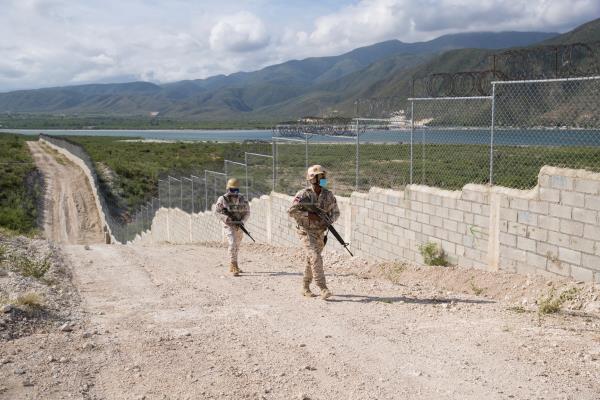RIO DE JANEIRO, BRAZIL – The Dominican Republic had already built 23 kilometers of fence along the border with Haiti, in work begun before President Luis Abinader announced plans to erect a fence along the entire length of the dividing line to curb immigration and smuggling.
The sections built are located at the Jimani and Elias Piña border crossings. The second and third most important between the two countries, and work is still underway, said General Santo Domingo Guerrero Clase, director of Plans and Operations of the General Staff.
The Army discreetly carried out the construction, without major announcements by the Dominican authorities, who intend to control irregular immigration, in addition to curbing smuggling, arms and drug trafficking, and the theft of vehicles and livestock.
THE CONSTRUCTED FENCE
The longest section of the fence starts on Lake Azuei and winds through the arid hills bordering the Dominican city of Jimani, the closest to the border crossing on the road from Santo Domingo to Port-au-Prince.
The fence, about four meters high, sits on a cement brick wall and is topped by a spiral of razor wire, already with rust marks in some sections due to the humidity of the lake.
Guarded around the clock by soldiers of the Specialized Corps for Land Border Security (Cesfront), the fence cuts in two the rocky paths that smugglers and traffickers used to access Dominican land from the lake, according to the military who guard the fence.
The other section already completed, built between 2019 and 2020, stands in the hills near Elías Piña, the official crossing point between the Dominican Republic and Haiti, located in the center of the Caribbean island.
THE NEW TECHNOLOGICAL FENCE
Last February, President Abinader solemnly announced, during his speech before the National Congress, the construction of a fence along the entire border, accompanied by technological systems, such as facial recognition cameras, motion, and infrared sensors.
The objective, according to Abinader, is to put an end within two years to irregular immigration, drug trafficking, smuggling, and the theft of vehicles and livestock.
General Jose Manuel Duran, commander of the Cesfront, explained that the fence would not cover the 380 kilometers of the border, as it will not be necessary for the mountainous areas, and will only be installed in “neuralgic places”, which are currently considered “vulnerable”.
“All the threats that we face daily, with this work will be significantly controlled because there is no way to pass a cow that was stolen from the Dominican side by a height of 15 feet, nor a vehicle,” said General Durán in Dajabón, the main crossing point between the Dominican Republic and Haiti, located in the north of the island, and where there is still no fence.
Currently, the companies interested in the new fence project are preparing their surveys to submit proposals for the construction, which should begin before the end of the year.
According to military sources, the new fence will probably begin construction at Pedernales, the southernmost and least traveled of the four official border crossings.
CRITICISM OF THE FENCE
Before announcing the construction, the Dominican government informed the Haitian government of its plans, although the construction runs entirely through Dominican territory, about four meters from the border markers.
The project has caused controversy and has been criticized by Dominican and Haitian businessmen, entrepreneurs, and human rights organizations.
Haitian activist Jesula Blanc, the coordinator of the Mesa de Diálogo Transfronterizo, believes that the fence is a “disadvantage for vulnerable people”, especially for the thousands of migrants who cross every month into the Dominican Republic in search of work.
“What we can see is that they want to put more conflict, to put the people more on their backs,” Blanc told Efe in her office in the Haitian city of Ouanaminthe, from where she works mediating conflicts that arise between the two countries on the border of Dajabón.


